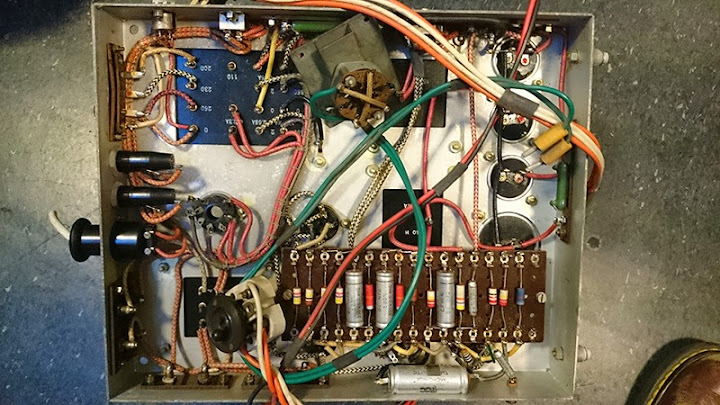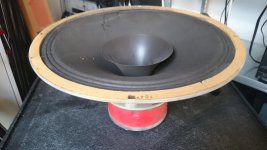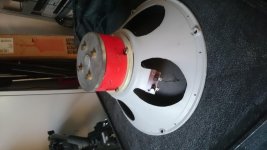Hi
I had to get rid of an old radio gram which was pretty beaten up. I decided to have a look at the innards and pulled some of the valves.
There are 2 PX4's and a few other valves.
I know very little about valves but have experience with Quad solid state amps and also vintage synthesizers.
I would really like to build a valve amp and attempt to use these PX4's in it. I believe they are well regarded as far as audio quality goes.
I also pulled the old amplifier chassis which is quite nice. I believe it is mono. Possibly an RGD 1046
My questions are..
is it worth trying to use the old chassis to build an amp?
Are here any kits to guide one in building a valve amp from scratch?
many thanks



I had to get rid of an old radio gram which was pretty beaten up. I decided to have a look at the innards and pulled some of the valves.
There are 2 PX4's and a few other valves.
I know very little about valves but have experience with Quad solid state amps and also vintage synthesizers.
I would really like to build a valve amp and attempt to use these PX4's in it. I believe they are well regarded as far as audio quality goes.
I also pulled the old amplifier chassis which is quite nice. I believe it is mono. Possibly an RGD 1046
My questions are..
is it worth trying to use the old chassis to build an amp?
Are here any kits to guide one in building a valve amp from scratch?
many thanks



Last edited:
Member
Joined 2009
Paid Member
hey thanks guys. Wow $1000 dollars. I just hope they are working now. I have not tried them. They 'look' in good condition but i'm not sure how sturdy they are
I would replace the control grid capacitors on the PX4s and power it for half an hour with a light bulb in series while monitoring the temperature of the capacitor cans.
Once they run cool you should have a nice amplifier and it can then be powered at full voltage.
Once they run cool you should have a nice amplifier and it can then be powered at full voltage.
I had no idea these tube were so rare/expensive. Whatever you do, be careful!
PX4 audio valve, triode amplifer tube
PX4 audio valve, triode amplifer tube
wahee.
The PX4 amplifier may be worth a lot to a collector. Most likely you would get sufficient money to build, buy yourself a pair of very good amplifiers using valves that are more easily obtainable.
The amp in your photo is likely to be one designed by Osram GEC.
I think I have a circuit, the same circuit also used KT66's as triodes.
Phil
The PX4 amplifier may be worth a lot to a collector. Most likely you would get sufficient money to build, buy yourself a pair of very good amplifiers using valves that are more easily obtainable.
The amp in your photo is likely to be one designed by Osram GEC.
I think I have a circuit, the same circuit also used KT66's as triodes.
Phil
hey thanks guys. Wow $1000 dollars. I just hope they are working now. I have not tried them. They 'look' in good condition but i'm not sure how sturdy they are
Under no circumstances, should power be applied to that old carcass. The ancient electrolytic caps. have all but certainly dried out and applying power could destroy the valuable tubes and "iron".
The 1 getter I see looks STRONG. That means the envelope is quite intact, which is highly encouraging.
1K$ would fund any number of nice projects. OTOH, you already have power magnetics that can be recycled. It's not an easy decision.
SE O/P "iron" is big. Therefore, I suspect a new chassis will be needed, should you decide to use the PX4s in a stereo setup. The PX4 sockets should be reusable.
Any rational design will begin with the PX4 data sheet. FWIW, I'd use an operating conditions set that does not dissipate the max. 15 W. Doing so will extend the service life of the PX4s.
Please notice that you will need upper 90s sensitive speakers, as power O/P is very limited.
Last edited:
I would replace the control grid capacitors on the PX4s and power it for half an hour with a light bulb in series while monitoring the temperature of the capacitor cans.
Once they run cool you should have a nice amplifier and it can then be powered at full voltage.
hi many thanks for the advice. Is that the 0.1UF metal caps across the wiring ladder with the resistors? I think the larger ones on the topside of the amp are smoothing?
Under no circumstances, should power be applied to that old carcass. The ancient electrolytic caps. have all but certainly dried out and applying power could destroy the valuable tubes and "iron".
The 1 getter I see looks STRONG. That means the envelope is quite intact, which is highly encouraging.
1K$ would fund any number of nice projects. OTOH, you already have power magnetics that can be recycled. It's not an easy decision.
SE O/P "iron" is big. Therefore, I suspect a new chassis will be needed, should you decide to use the PX4s in a stereo setup. The PX4 sockets should be reusable.
Any rational design will begin with the PX4 data sheet. FWIW, I'd use an operating conditions set that does not dissipate the max. 15 W. Doing so will extend the service life of the PX4s.
Please notice that you will need upper 90s sensitive speakers, as power O/P is very limited.
hi advice much appreciated. I think I will take this one slow and easy as I recently destroyed a rather nice spendor speaker magnet through my own stupidity.
I would like to keep the 1046 chassis as I do enjoy refurbing old kit.
Is it wise to replace all the old electrolytics? I was looking at Jenson, F&T etc which seem to do decent enough replacements. I would perhaps use the metal can shell for the smoothing caps to keep the look.
The resistors I will check with a meter before power up.
I currently don't have the knowhow to build my own amp but it's something I would love to do in the future.
I also have some higher resolution images of the valves...which may or may not show more detail
thanks again
https://picasaweb.google.com/113787059283443546386/30January2015?authuser=0&feat=directlink
With those old capacitors they can be restored as long as the electrolyte has not leaked by adding a diode and 100K 2W resistor in place of one of the rectifier sections in the power supply. Take all the valves out and keep them safe. Then leave power applied over night. Next morning connect a DMM across the resistor to see how much currant they are taking. Now shut the power down and see how long they take to discharge. The voltage across the resistor should fall to about 50 volts and they should take 10 to 15 seconds or longer to fall to 20 volts.
The capacitors in the chassis look leak free so they should respond to this treatment.
The capacitors in the chassis look leak free so they should respond to this treatment.
Show us the markings on those caps, They look awfully large for electrolytes.
Edit, they seem to be polarized, my bad
Anyway, as those electrolytes are so large you could fit in some decent oil caps instead of the electrolytes the unit came fitted whit.
As the Oil caps still have applications in industry they will likely only be marginally more expensive than the boutique offerings.
Edit, they seem to be polarized, my bad
Anyway, as those electrolytes are so large you could fit in some decent oil caps instead of the electrolytes the unit came fitted whit.
As the Oil caps still have applications in industry they will likely only be marginally more expensive than the boutique offerings.
Last edited:
Member
Joined 2009
Paid Member
that old chasis with the px4 tubes may be worth a lot more if you dont mess with them or the chasis i.e. leave well alone. perhaps better to store it away til you have more knowledge or sell it as is and spend the profits?
Spot on. It's rude to tamper, and near certainly you'd regret it once you've acquired enough knowledge. Put it aside and ponder on why fortune has gifted you this thing 😉 Just my 2pworth.that old chasis with the px4 tubes may be worth a lot more if you dont mess with them or the chasis i.e. leave well alone. perhaps better to store it away til you have more knowledge or sell it as is and spend the profits?
I should put it in the cupboard and not fiddle with it. It will be a week or so before I will be able to start anyway. I will spend the time getting up to speed with valves. I's sort of too late as I have ordered Jensen OIP metal cans and new electrolytic's. The valves are just too tempting
I have a Quad33 preamp to restore at the moment so it will be a while before I get to the valve amp.
I don't intend to do much, cap replace, minimal cleanup, contact clean and repaint transformers.
I have a Quad33 preamp to restore at the moment so it will be a while before I get to the valve amp.
I don't intend to do much, cap replace, minimal cleanup, contact clean and repaint transformers.
Last edited:
The magnetic parts look like Woden, so they are a great start for a rebuild using another output stage valve (with a change of base, and some heater ingenuity), especially given the chassis and parts are all there. And as you indicate, you are likely to enjoy the learning curve.
The first 500 years are the worst, after that it gets easier I hear. If I were you I'd read up on capacitor restoration and testing, and attempt that before modifying.........even if you've bought the parts, they'll do for something else. Often it's how capacitors are woken from their coma that determines the prognosis IME. I think someone already pointed this out on the thread IIRC.I should put it in the cupboard and not fiddle with it. It will be a week or so before I will be able to start anyway. I will spend the time getting up to speed with valves. I's sort of too late as I have ordered Jensen OIP metal cans and new electrolytic's. The valves are just too tempting
I have a Quad33 preamp to restore at the moment so it will be a while before I get to the valve amp.
I don't intend to do much, cap replace, minimal cleanup, contact clean and repaint transformers.
well I think I have found my first problem upon doing a basic unpowered check. The 2 (2a) fuses are blown. I checked wiring to the voltage input selector screw in switch and found that the input was sent to 250, 230 and 200 windings of the transformer.
got the voltage selector sorted out. The UU7 rectifier also seems to be dead. With no DC on the output. I have spotted a UU8 on ebay so shall invest in one.
The smoothing caps read 80uF for the 4 (2x16 & 1x32). They also seem in good shape.
I will attempt a recharge as described in the earlier posts.
All the resistors check out ok on a DVM.
The 0.1uf caps also check out ok on a capacitance meter.
I have also been able to get the original speaker from the rather beaten uo radiogram, so I will use this as a test later on.
I have now to find the audio input
The smoothing caps read 80uF for the 4 (2x16 & 1x32). They also seem in good shape.
I will attempt a recharge as described in the earlier posts.
All the resistors check out ok on a DVM.
The 0.1uf caps also check out ok on a capacitance meter.
I have also been able to get the original speaker from the rather beaten uo radiogram, so I will use this as a test later on.
I have now to find the audio input
Attachments
Last edited:
- Status
- Not open for further replies.
- Home
- Amplifiers
- Tubes / Valves
- Got some PX4 valves from an old radiogram

